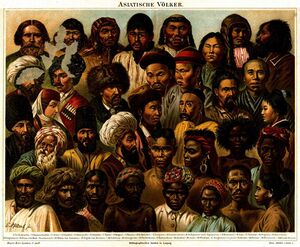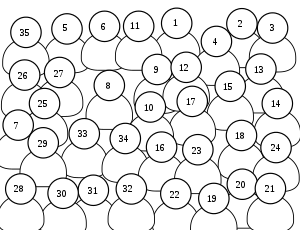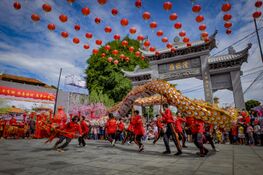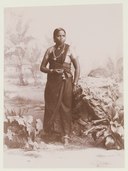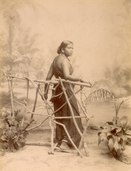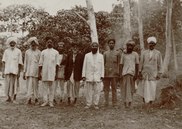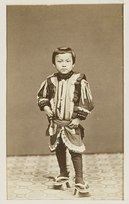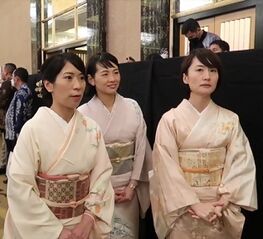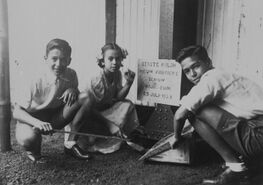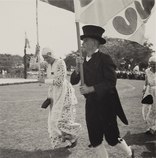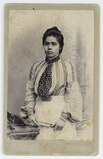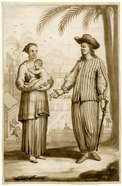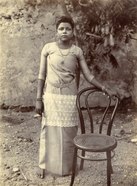Ethnic groups of Indonesia
Topic: Social
 From HandWiki - Reading time: 14 min
From HandWiki - Reading time: 14 min
According to the official ethnographic data of the Republic of Indonesia, there are at least 1,340[1][2] recognised distinct ethnic groups who inhabit more than 18,300[lower-alpha 1] islands of Indonesia.[4][5][6][7]
In addition, according to the official national law of Indonesia (especially in 1999 Law on Human Rights), there is no superiority of particular ethnic group; all ethnics in Indonesia are treated equally and protected by the laws.[8]
History
Early official data
After the 1928 Youth Pledge declaration momentum, the official census by the citizens started to emerged, and along with that, the ethnographics data of Indonesia was first officially published through the 1930 Population Census (Sensus Penduduk 1930, abbreviated as SP 1930) by the local Indonesians in Java under the Dutch colonial supervision.[9]
Termination
In early independence of Indonesia, the data collecting process was temporarily stoped especially during the New Order era (in 1966–1998) due to the dictatorship of Soeharto (the second president of Indonesia) who impose his political views to not including non-Native Indonesians (especially targeted to the Chinese Indonesians) as part of 'Indonesians' due to the statement and policy of Mao Zedong on Chinese-descent (partially or fully) who stated that all people related to Chinese are nationally People's Republic Chinese, while in fact, the independence of Indonesia was earlier than the People's Republic of China, and the Chinese-descent people have already miggrated and settled in Indonesia since ancient times. The Chinese-descent people in Indonesia have some sort of difficulty to understand the situation and hard to assigned themselves as either nationally Indonesian or People's Republic Chinese; due to these social phenomenon, the ethnographic data collection proccess was considered as ‘political taboo’ since it was deemed as one of the government's tools to break the unity of Indonesian nation.[9]
Revival
After almost 70 years later, in post-Soeharto era, the government of Indonesia started to officially active again to continue its paused population census (which also including the ethnographic census) and the 2000 Population Census (Sensus Penduduk 2000, abbreviated as SP 2000) officially published in 2000. Since then, it was officially set that the population census will be officially published every 10 years (a decade), thus being said, the 2010 Population Census (Sensus Penduduk 2010, abbreviated as SP 2010) and 2020 Population Census (Sensus Penduduk 2020, abbreviated as SP 2020) are already available to observe the demographics of Indonesia, particularly in ethnography sector.[9]
Current
The latest official ethnographic data of Indonesia shows that at least 1,340 distict ethnic groups which inhabited the 18,000 islands of Indonesia. The collaborative ethnographic researchs also shows that each island of Indonesia has its own indigenous ethnic community, but their existence was reduced to circa 1,400 due to numerous factors, and one of them due to European colonizations (e.g. genocide, etc.).[9]
Classification
Native and/or official classification
According to the official laws, the classification of ethnicity is strongly adhered to the anthropology, what defined as an ethnic in Indonesia is "unified social community that are distinctive to another community based on the lineages (blood, ancestral origin homelands, etc), awareness of identity, cultures (not limited to folk religious view), and spoken languages".[10] In the Undang-Undang Tentang Penghapusan Diskriminasi Ras dan Etnis Nomor 40 Tahun 2008 (lit. Law No. 40/2008 on the Elimination of Racial and Ethnic Discrimination), the ethnicity of Indonesia also further defined as "sociogrouping based on (folk) beliefs, values, habits, customs, languages, norms, history, geography, and kinship".[11] As a unified nation, Indonesians are originally formed from different native nations (first nations); thus sometimes, some ethnic groups are defined or called natively as the Suku Bangsa which literally means "subnation" (the subgroup of Indonesian nation), etymologically derived from suku (lit. sub) + bangsa (lit. nation) (in Javanese). Those Suku Bangsa (lit. subnation) itself have its own subgroup (either as tribe or ethnic) that might have its own distinctive clans, cultural customs, etc. One of the well-known native/first nations of Indonesia (subnations of Indonesian nation) are the Batak, a multiethnic group which had its own unique defined distinctive ethnic groups, namely the Angkola, Dairi, Karo, Mandailing, Pakpak, Simalungun, Toba, Alas, Kluet, Singkil, etc alongwith their own marga (lit. clans (in Batak languages)), native Batak writing system, etc.[9] However, not all ethnics of Indonesia are originally a nation, some are ultimately a tribe that was branched out from its initial ancestral nation, these 'branched out' groups usually characterized by the absence of clans, traditional native writing system, and folk religious view, as well as adoption of cultures and traditions from different group (one of the extreme cases usually characterized by the adoption of the cultures of unrelated groups of different ancestral lands, etc).
Unlike most countries, the native classification for ethnicity in Indonesia was never rely or adhered to any racial grouping, since racism has always been deemed by the Native Indonesians as the product of colonization and newly proposed European-centered vision that essentially has no sturdy definition and benchmarks.[11]
Non-native classification
According to European/Western/White/Non-native Indonesian classification, the ethnic groups of Indonesia could be defined through racial grouping, namely continental-based racial grouping (e.g. Asian, African, etc), skincolor-based racial grouping (e.g. brown, yellow, black, etc), and skin complexion-based grouping (e.g. dark, light, etc). For instance, the Western Indonesia predominantly inhabited by the light yellow skin Asians, meanwhile the Eastern Indonesia predominantly inhabited by the dark brown (and black) skin Asians which later termed as Austronesians, Australasians, Austromelanesians, Melanesians, etc. However, it is best to take note that those are only European-based hypothetical classification, none of Native Indonesians called or identified themselves as one of those racial grouping since those are new proposed ideology that did not really represent the native identity nor the real proven historical origin of each native Indonesian ethnic groups. Rather than race grouping, ethnics of Indonesia are adhered to proven historical native classification.[11]
Indigenous
The terminology for "indigenous" in Indonesia are known variously according to each ethnic languages; however, some of well-known terms are including the pribumi (in Javanese), inlander (in Petjo), lantak nagari (in Minangkabau), masyarakat adat (in Indonesian), etc. All native ethnic groups of Indonesia could identify and still resides in their ancestral homeland origin; however, due to multiple migration (e.g. national transmigration program, tribal wars, etc.), some significant proportions of ethnic groups might also resides outside of their ancestral origin regions.
In Bali
There are two main native ethnic group of the Bali Island, namely the Balinese and Bali Aga. Both are the indigenous of Bali, but the Balinese are the one who already mixed with Javanese; thus, in terms of lineage, customs, clans, and cultures are exhibited significant differences.
In Java
The indigenous of the Java Island are commonly called as the Javans,[12] these community consist of several ethnics namely the Javanese itself which mostly native to the central, southern, and eastern regions of Java, the Tengger which native to the Tengger Mountains region, the Osing which native to easternmost region of Java, the Banyumasan (or a.k.a. Ngapak) native to northern regions of Java, the Sundanese native to western regions of Java, the Baduy native to the regions alongside the Cibaduyut (lit. Baduyut River), the Banten native to westernmost region of Java, the Cirebonese native to Cirebon and its adjacent regions, the Betawi native to northern West Java, and Kalang native to central Java.
In Kalimantan
There are several indigenous groups of Kalimantan, but most of the ethnics are clumped as the Dayak which traced their ancestral homeland origin in Tanah Dayak (lit. Dayak Land) located in southern central region of Kalimantan. Some ethnics branched out from Dayak are mostly lived in coastal regions, namely the Banjar native to Banjar Region, the Kutai native to Kutai Kartanegara, the Paser native to Paser regions, the Tidung native to Tana Tidung (lit. Tidung Land), etc.
In Madura
The Madurese are the native ethnic of the Madura Island. However, there are several subethnic groups of Madurese namely the Baweans who settled in Bawean Island and Pandalungan which mostly dominated Jember and its adjacent regions in the island of Java.
In Maluku
The archipelago of Maluku (a.k.a. Moluccas) are inhabited by several indigenous ethnics, namely the Alfur native to Alfur regions, the Ambonese native to Ambon Island, the Nuaulu native to soutern regions of Seram Island, the Manusela and Wemale native to Manusela regions of Central Maluku, the Tanimbar native to Tanimbar Islands, etc.
In Nusa Tenggara
The Lesser Sunda Islands are natively called as Nusa Tenggara Islands. There are numerous distinct ethnic groups inhabit different islands, namely the Sasak which native to Lombok Island, the Kangeanese native to Kangean Island, the Sumbawan and Bima native to Sumbawa Island, the Manggarai native to Manggarai regions, the Lamaholot native to eastern Flores, the Atoni and Tetun native to western regions of Timor Island, the Helong native to Kupang and its adjacent regions, Rote native to the Rote Island, the Savu native to Savu Island, the Sumba native to Sumba Island, Alorese native to Alor Islands, etc.
In Papua
The western regions of the New Guinea Island is home to various indigenous ethnics, the Asmat are native to Asmat regions, the Dani native to the Jayawijaya Mountainous regions, the Bauzi native to regions alongside the Danau-danau Plains, the Amungme native to western regions of Jayawijaya, etc.
In Sulawesi
The natives of Sulawesi are collectively known as Sulawesi (or Celebesian in outdated English terminology), some of the notable ethnics are the Bugis, Makassar, and Mandar which native to southern regions of Sulawesi, the multiethnic of Minahasan native to northern regions Sulawesi, the Torajan native to Tana Toraja (lit. Toraja Land), the Gorontalo native to Gorontalo and its adjacent regions, etc.
Sumatra
The indigenous of the Sumatra Island are commonly called as the Sumatrans, there are numerous ethnics in Sumatra which exhibits distinct characteristics to one another. Some of the ethnics are including the Abung, Ogan, Komering, and Lampung which native to southernmost region of Sumatra, the Palembang native to southeastern region of Sumatra, the Musi native to regions alongside the Musi River, the Basemah native to south central regions of Sumatra, the Rejang native to Rejang Lebong regions, Kerinci native to Kerinci Mountainous regions, Minangkabau native to Minangkabau Highlands, the multiethnic of Batak native to central and northern regions Sumatra, the Acehnese native to northernmost regions of Sumatra, the Gayo native to central northern highlands of Sumatra, the Melayu native to easternmost coastal regions of Sumatra, etc.
Non-indigenous
Throughout the Indonesian history, various ethnic groups of foreign origin spread throughout Indonesia in several migration waves, and usually established themselves in urban centres, seldom settling rural parts of the country.
Arab Indonesians
Clockwise from upper left:
Arab Indonesians in Tegal, Arab woman of Java, Dutch account on Arabs settlement in northern Surabaya, Depiction of Arab in Java Island, The Babad Diponegoro (lit. Chronicle of Diponegoro) written in Pegon (Arabic-based script of Javanese), Arab-descent female immigrant in Java.
The Arabs are one of the people who migrated to Indonesia since ancient times from different regions of Middle East (notably Saudi Arabia and Yemen), some of notable ethnic groups of Arabs in Indonesia are including the Bedouin (also commonly known in Indonesia as Badawi, from ar بَدَوِي 'badawī'), Hadhrami (also commonly known in Indonesia as Hadramaut), and Sabaeans (also commonly known in Indonesia as Sabian). In the island of Java, they are mostly concentrated around Puncak of Bogor, Pasar Kliwon of Surakarta, Ampel of Northern Surabaya, Jakarta, Malang, Probolinggo, etc.
Chinese Indonesians
Clockwise from upper left:
Liong (lit. Chinese dragon) performance in Yogyakarta, The worship of Dewa Jodoh (lit. God of Match in Chinese Indonesians tradition), Ritual at Jin De Yuan temple at Glodok region of Jakarta, 2019 Hungry Ghost Festival in Medan of North Sumatra, Chinese deity statue at Sam Poo Kong temple in Semarang, Chinese New Year celebration in Central Java.
The Chinese are one of the most significant people of foreign origin in Indonesia. Some of the notable ethnic groups of Chinese in Indonesia are including the Hokkien (also commonly known in Indonesia as Hokian), Hakka (also commonly known in Indonesia as Khek or Khek-ngin), Teochew (also commonly known in Indonesia as Tiociu), Cantonese (also commonly known in Indonesia as Kanton), Fuzhou (also commonly known in Indonesia as Hokciu), etc.[13] These community are mostly concentrated in locations natively known as ꦏꦩ꧀ꦥꦸꦁꦕꦶꦤ (Kampung Cina, lit. [the] settlement of Chinese) or ꦥꦼꦕꦶꦤꦤ꧀ (Pecinan, lit. chinatowns (in Javanese)) in urban coastal regions of Java Island (mainly in northern Jakarta), Kalimantan Island (mainly in Pontianak), Sumatra Island (mainly in Medan, Riau, Palembang, and Jambi), Riau Islands, Bangka Island (mainly in northern Bangka), etc.[13]
Due to long progressive historical ties between Indonesia and People's Republic of China (as well as Republic of China (ROC, a.k.a. Taiwan)), the intermarriage is an unavoidable phenomenon occured within the society. In Java Island, the mixed people of Native Javanese and Non-native Javanese (which also include the Chinese) are natively called as the ꦥꦼꦫꦤꦏꦤ꧀ (Peranakan, lit. crossbreed (in Javanese)) community (e.g. the Peranakans of Benteng, Lasem, etc.), etymologically Old Javanese in origin, derived from the basic word of ꦲꦤꦏ꧀ (anak), which literally means "child" (as in passim);[14] eventhough it was originally a neutral term encompass all mixed people on the island of Java, nowadays the Peranakan terminology closely associated with Chinese Javanese (part of modern-day Chinese Indonesians) due to the significant population of Chinese-descent people (compared to another 'mixed people' community) in Java. In Sumatra Island, the mixed people of Native Sumatrans and Chinese are natively identified as the community of Kacukan (in Palembang) or Kacauan (in Malay), which literally means "blended". Meanwhile in Warmar Island of northern Aru Islands, the mixed people of Native Aru and Chinese are commonly known as the community of Jar (in Aru), which literally means "mixed".[15]
Indian Indonesians
Clockwise from upper left:
Indian-descent female in Medan, Indian Indonesian (of Klingalese) woman in Medan, The Tamil Indonesians community at Sri Mariamman temple in Medan, Tamil settlements in Deli Serdang, Indian clothing tradition of Jakarta, The Indian Indonesians of Batavia-Deli in Deli Serdang.
Indians are amongst one of the earliest people who travelled to Indonesia to expand their business. Some of the notable ethnic groups of Indian origin are including the Indo-Aryan of Madra (also commonly known in Indonesia as Madras), Marathi (they originates mainly from Mumbai, thus these people also commonly known in Indonesia as Bombai), Tamil, etc. They are mostly concentrated in urban centres known locally as the Kampung India (lit. Indian settlement) or with another nicknames corresponds to each ethnic or historical origin regions, such as the ᯂᯔ᯲ᯇᯮᯰᯔᯑ᯲ᯒᯘ᯲ (Kampung Madras, lit. [the] settlement of Madras) in Medan which mostly inhabited by the Madra ethnic, ꦏꦩ꧀ꦥꦸꦁꦏ꧀ꦭꦶꦁ (Kampung Keling, lit. [the] settlement of Kalinga Indians) in several regions of Java, etc. Significant population of Indian Indonesians are centered in Sumatra Island (mainly in North Sumatra) and Pasar Baru of Jakarta in Java Island.
Japanese Indonesians
Clockwise from upper left:
Japanese-descent woman in Jakarta (formerly Batavia), Japanese boy in Jakarta, Musical instrument played by the Japanese woman in Jakarta, Java's Japanese, Japanese woman wearing the Kimono, The Japanese Indonesians delegates during the Naruhito's 63 birthday celebration.
Japanese are one of the notable East Asians who migrated to Indonesia since ancient times, one of the reasons is to built the business with the Native Indonesians. As the business has been going back-and-forth from the islands of Japan to Indonesia, some ethnic group of Japan such as Okinawan of Ryukyuan are also influenced by the Native Indonesian cultures, such as in culinary tradition where the チャンプルー (Chanpurū, from jv ꦕꦩ꧀ꦥꦸꦂ 'campur', lit. mix) being a staple in Okinawa regions which derived from the ancient Javanese cuisine of ꦤꦱꦶꦕꦩ꧀ꦥꦸꦂ (nasi campur, lit. Javanese mix rice; Nasi campur). During the World War II, the migration wave of Japanese to Indonesia also increase when Japan started to expand their power in Indonesia, especially to the islands of Java and Bali where the Native Japanese and Native Indonesians used to make business cooperation since ancient times. Nowadays, the existence of Japanese Indonesians (Indonesians of fully or partially Japanese-descent) are still exist in several regions of Bali and Java, where the ラーメン (ramen, lit. Japanese noodle; Ramen) also become one of the most popular Japanese-origin noodle culinary heritage which can be easily found in malls or shopping centers all across Indonesia (especially Bali and Java).
Korean Indonesians
Clockwise from upper left:
Korean Indonesians cultural performance at the Korean Cultural Center in Jakarta.
Korean Indonesians are referring to Indonesians of Korean-descent (partially or fully) from both northern and southern regions of Korea. As one of the ethnic group of East Asian in origin, the existence of Koreans in Indonesia could be linked to the business trade activity between Native Indonesians and Native Koreans. The Koreans has been co-existed in Indonesia since ancient times alongwith Chinese and Japanese, and their main settlements were and still in the Indonesian island of Java. Korean Indonesians are also one of the people who showed great support for the independence of Indonesia, 양칠성 (Yang Chil Seong) or natively known as ꦏꦺꦴꦩꦫꦸꦣꦶꦤ꧀ (Komarudin (in Javanese)) or 梁川七星 (Sichisei Yanagawa (in Japanese)) is one of the Korean Indonesians figures who fought for Indonesia during the Japanese colonialization era. Some notable Korean-origin heritages in Indonesia usually can be found side-by-side with Japanese (or even Chinese) cultures. Due to Korean influence, some Indonesian words are etymologically derived from Koreanic, namely bancan (from kor 반찬 'banchan', lit. Korean side dishes; Banchan), bibimbap (from kor 부븸밥 'bubuimbap', lit. Korean mixed rice; Bibimbap), bingsu (from kor 빙수 'pingsu', lit. Korean shaved ice; Bingsoo), gocujang (from kor 고추장 'gochujang', lit. Korean condiment; Gochujang), hanbok (from kor 한복 'hānpok', lit. Han Korean clothing; Hanbok), kimci (from kor 김치 'gimchi', lit. Korean pickle; Keemchee), mandu (from kor 만두 'mandu', lit. Korean dumpling; Mandoo), manhwa (from kor 만화 'manhua', lit. Korean comic; Manhwa), mokbang (from kor 먹방 'meokbang', lit. eatshow; Mukbang), mukbang (from kor 먹방 'meokbang', lit. eatshow; Mukbang), and oppa (from kor 오빠 'oppa', lit. older brother).[16]
Netherland Indonesians
As one of the longest former colonies of the Netherlands, several ethnic groups of Netherlands origin also exist in Indonesia, such as the Dutch and Frisians. The mixed people of native Indonesians and Netherlands also emerged in both Indonesia and Netherlands especially in the era of Dutch East Indies, which they classified themselves as a unique community group called the Indo people (colloquially also known as the Indos). Nowadays they (especially the Indos) live mostly in Jakarta. As of 2011, an estimated 124,000 Indos were residing outside of the Netherlands (which including Indonesia).[17]
Portuguese Indonesians
Clockwise from upper left:
Depiction of Mardijker (Indonesians of Portuguese-descent), Portuguse-descent female in Timor Island.
According to historical colonial records of Indonesia, Portugal are one of the European countries who came to Indonesia as colonizer. Portuguese (also commonly known in Indonesia as Tugu) are the largest ethnic group of Portugal origin that still exist in Indonesia, its descendants also married to Native Indonesians which resulted the existence of Mardijkers, which are the Portuguese-descent people that are known for its historical support for the independence of Indonesia, however, the Mardijkers are not really a direct descent of Portuguese but already mixed with Indians as well, thus Mardijkers are basically the 'mixed people' of Portuguese, Indians, and Indonesians; the name Mardijk itself is a self-designated name which derived from the Sanskrit मार्डीक (Mardhika) or महर्द्धिक (Maharddhika), which commonly referred as "freedom" corresponds to the independence of Indonesia. Some notable regions with significant Portuguese-descent population are located in Jakarta on Java Island, where they resides in settlements natively known as ꦏꦩ꧀ꦥꦸꦁꦠꦸꦒꦸ (Kampung Tugu, lit. [the] settlements of Portuguese), and some regions in Timor Island.
References
- ↑ Na'im, Akhsan; Syaputra, Hendry (2011). "Nationality, Ethnicity, Religion, and Languages of Indonesians" (in id). Statistics Indonesia. http://www.bps.go.id/website/pdf_publikasi/watermark%20_Kewarganegaraan%2C%20Suku%20Bangsa%2C%20Agama%20dan%20Bahasa_281211.pdf.
- ↑ "Mengulik Data Suku di Indonesia" (in id). Statistics Indonesia. 18 November 2015. https://www.bps.go.id/news/2015/11/18/127/mengulik-data-suku-di-indonesia.html.
- ↑ Purwanto, Heru, ed (10 January 2017). "Indonesia to register 14,752 officially named islands with UN". Antara News. https://en.antaranews.com/news/108862/indonesia-to-register-14752-officially-named-islands-with-un.
- ↑ Taylor 2003, pp. 5–7.
- ↑ Witton 2003, pp. 139, 181, 251, 435.
- ↑ Dawson, B.; Gillow, J. (1994). The Traditional Architecture of Indonesia. London: Thames and Hudson Ltd.. p. 7. ISBN 978-0-500-34132-2.
- ↑ Truman Simanjuntak; Herawati Sudoyo; Multamia R.M.T. Lauder; Allan Lauder; Ninuk Kleden Probonegoro; Rovicky Dwi Putrohari; Desy Pola Usmany; Yudha P.N. Yapsenang et al. (2015) (in id). Diaspora Melanesia di Nusantara. Direktorat Sejarah, Direktorat Jenderal Kebudayaan, Kementerian Pendidikan dan Kebudayaan. ISBN 978-602-1289-19-8. https://gln.kemdikbud.go.id/glnsite/diaspora-melanesia-di-nusantara/. Retrieved 2022-08-24.
- ↑ "Indonesia - Law on Human Rights (No. 39 of 1999)" (in id, en). International Labour Organization. https://ilo.org/dyn/natlex/natlex4.detail?p_lang=en&p_isn=55808&p_country=IDN&p_count=610&p_classification=01&p_classcount=81.
- ↑ 9.0 9.1 9.2 9.3 9.4 "Mengulik Data Suku di Indonesia" (in id), Badan Pusat Statistik [Central Bureau of Statistics of the Republic of Indonesia], 2015, https://www.bps.go.id/news/2015/11/18/127/mengulik-data-suku-di-indonesia.html
- ↑ "Etnik" (in id). Etnik. https://kbbi.kemdikbud.go.id/entri/Etnik.
- ↑ 11.0 11.1 11.2 "Indonesia - The Elimination of Racial and Ethnic Discrimination (Law No. 40/2008)" (in id, en). International Labour Organization. https://www.ilo.org/dyn/natlex/natlex4.detail?p_lang=en&p_isn=81470&p_country=IDN&p_count=611.
- ↑ Raffles, Sir Thomas Stamford (1830). The History of Java. 1. J. Murray. https://books.google.com/books?id=oA8PAAAAYAAJ&printsec=frontcover&dq=The+History+of+Java&hl=en&newbks=1&newbks_redir=0&source=gb_mobile_search&ovdme=1&sa=X&ved=2ahUKEwjS5fnTz6L6AhVcZWwGHRZyAcoQ6AF6BAgJEAM#v=onepage&q=Javan&f=false.
- ↑ 13.0 13.1 "Sejarah dan Budaya 4 Suku Tionghoa Terbesar di Indonesia" (in id). LingoAce. https://www.lingoace.com/id/trending/sejarah-dan-budaya-4-suku-tionghoa-terbesar-di-indonesia/.
- ↑ Zoetmulder, P.J. (1982). "Old Javanese-English Dictionary" (in en, kaw). Old Javanese-English Dictionary. Koninklijk Instituut voor Taal-, Land- en Volkenkunde.
- ↑ Kusumo, Rizky (2023). "Masyarakat Jar: Harmonisasi Keturunan Tionghoa di Kepulauan Aru" (in id). GoodNews From Indonesia. https://www.goodnewsfromindonesia.id/2023/01/09/masyarakat-jar-harmonisasi-keturunan-tionghoa-di-kepulauan-aru.
- ↑ "Kamus Besar Bahasa Indonesia (KBBI)" (in id). Kamus Besar Bahasa Indonesia (KBBI). https://kbbi.kemdikbud.go.id/.
- ↑ Beets, Gijs; van Imhoff, Evert (2004). "A Demographic History of The Indo-Dutch Population, 1930–2001". Journal of Population Research 21 (1): 47–72. doi:10.1007/BF03032210. https://publ.nidi.nl/output/2003/bt-51-01-beets.pdf.
Notes
- ↑ according to the official data of National Institute of Aeronautics and Space of the Republic of Indonesia[3]
 KSF
KSF